Today is the first day of green week for the #SoaptheRainbow series! I’m excited to start the “cool” colors, and I can’t wait to see all your beautiful projects. Share photos of projects featuring green on Instagram, Twitter and Facebook with the hashtag #SoaptheRainbow. I’m choosing favorites all week and posting them on the Bramble Berry Instagram page. The featured photos will win a $10 Bramble Berry gift certificate. In addition, a variety of colorants and fragrance oils are 25% off with the code: RAINSOAP. See the sale items here.
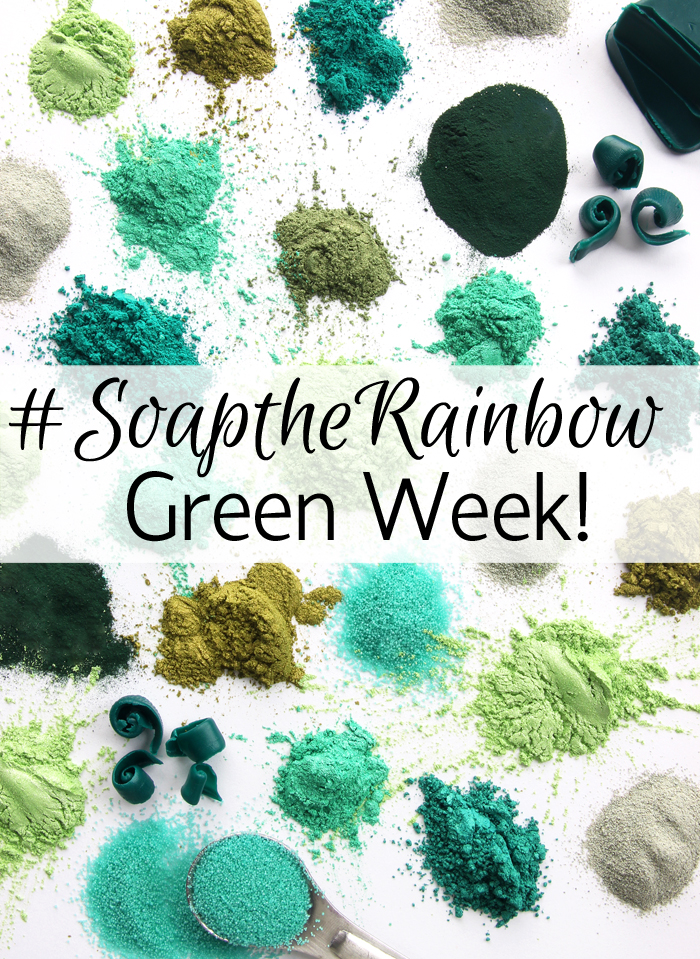
If you need inspiration for green projects, I’ve rounded up some of my favorite green tutorials. Green is such a wonderful color to craft with – there are so many options! If you like to craft with natural products, the Avocado + Spearmint Cold Process Soap Tutorial uses spirulina powder and French green clay for a soft green color. The natural colors do fade over time; scroll to the bottom of the post to see what the soap looks like after 5 months.
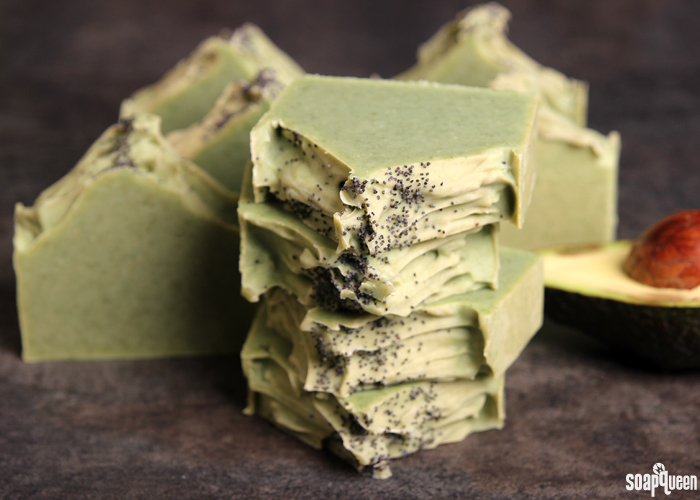 The Avocado + Spearmint Cold Process Soap Tutorial contain natural ingredients for a soft green color.
The Avocado + Spearmint Cold Process Soap Tutorial contain natural ingredients for a soft green color.
In the Lavender & Lemongrass Hot Process Soap on Soap Queen TV, spirulina powder and green zeolite clay are added. Green zeolite clay gives cold process soap a light green color and is known for its absorption properties. The true star of the show is the spirulina powder. It gives cold process and hot process soap a more vibrant color. The extra heat in hot process soap also makes the natural colorants more vibrant.
Spirulina powder is also effective in melt and pour soap. In the Minty Clay Melt and Pour Bars, it adds a contrasting stripe in between two white layers. In the Star Anise Melt & Pour Bars, green zeolite clay and spirulina powder create the base of the soap. Anise stars and cinnamon sticks are placed on top and embedded with a clear layer of melt and pour. If you prefer sparkle and shine, the Celtic Melt and Pour Tutorial features Celtic detailing colored with Evergreen Mica.
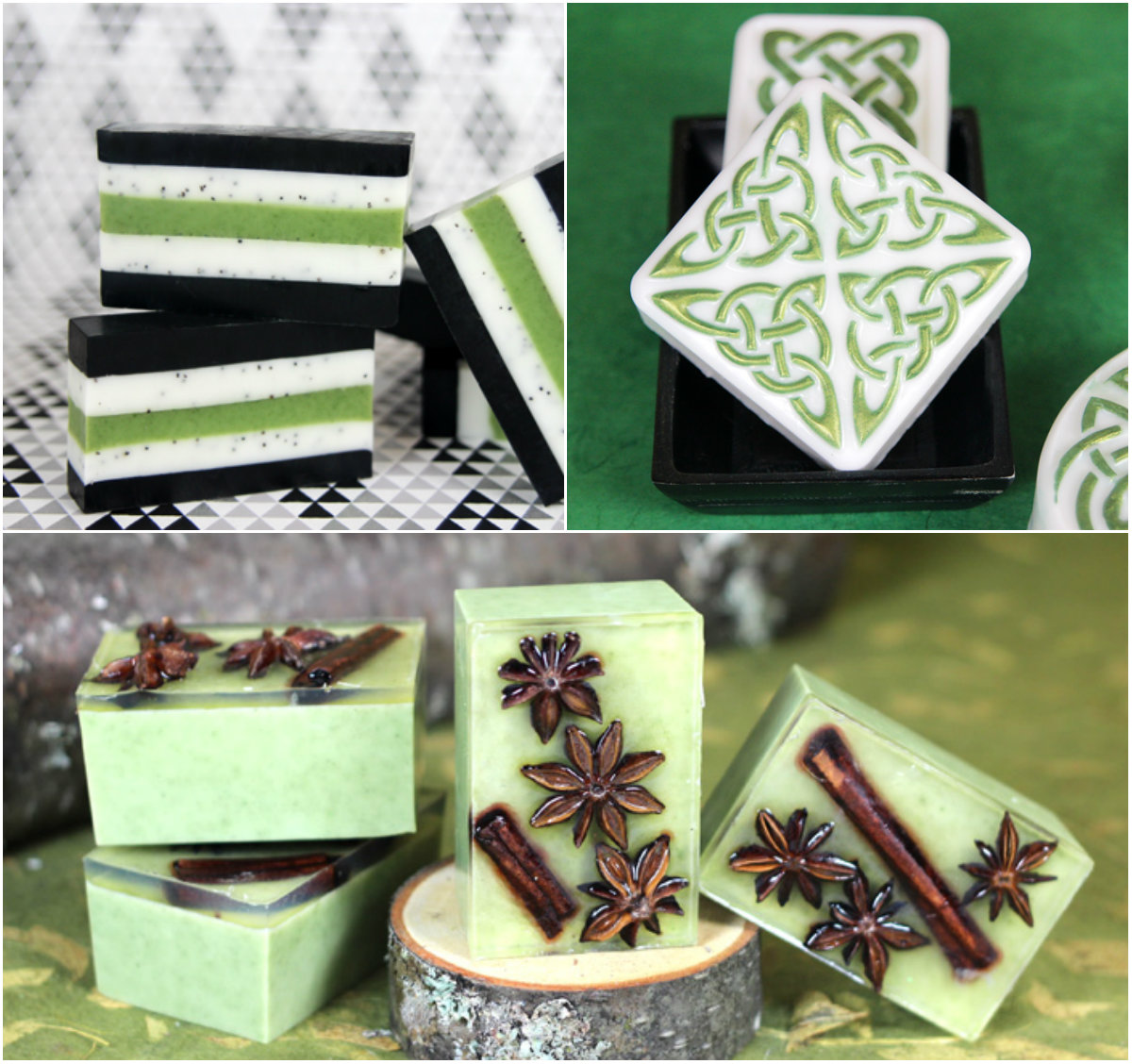 Top left, clockwise: Minty Clay Melt and Pour Bars, Celtic Melt and Pour Tutorial, Star Anise Melt & Pour Bars
Top left, clockwise: Minty Clay Melt and Pour Bars, Celtic Melt and Pour Tutorial, Star Anise Melt & Pour Bars
Oxide and pigment colorants are considered nature identical, as they are found in nature but created in a lab to eliminate impurities. They create vibrant colors in cold process soap that won’t fade like spirulina powder. Two of my favorites are Green Chrome Oxide Pigment and Hydrated Chrome Green Pigment. Both colorants are used in the Emerald Swirl Cold Process Tutorial. Green Chrome Oxide Pigment creates gorgeous swirls in the Bamboo Mint Impression Mat Cold Process Tutorial, as well as the Clover & Aloe Spin Swirl Soap on Soap Queen TV.
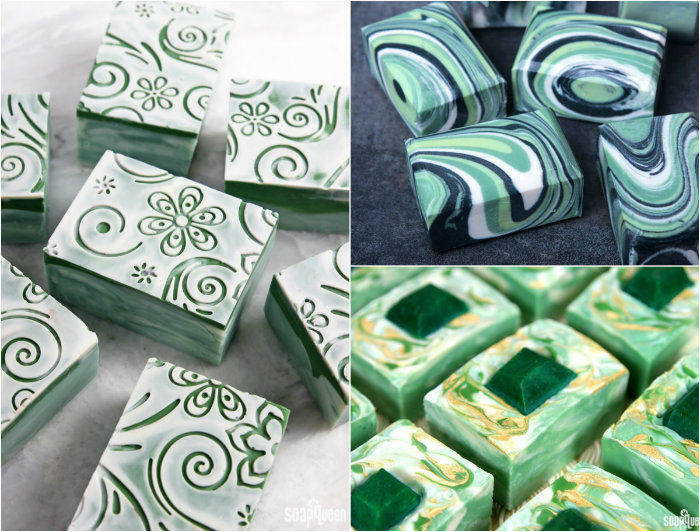 Left to right, clockwise: Bamboo Mint Impression Mat Cold Process Tutorial, Clover & Aloe Spin Swirl Soap, Emerald Swirl Cold Process Tutorial
Left to right, clockwise: Bamboo Mint Impression Mat Cold Process Tutorial, Clover & Aloe Spin Swirl Soap, Emerald Swirl Cold Process Tutorial
While you probably don’t want to wear green on the skin, a little bit of green colorant gives bath and body products a fresh hue. Kermit Green Mica and Emerald LabColor add a little bit of color to the Easy Creamy Cucumber Lotion DIY. LabColors are specially formulated to not transfer color to the skin when used in the correct amount. The Kermit Green Mica gives the skin the smallest amount of shimmer.
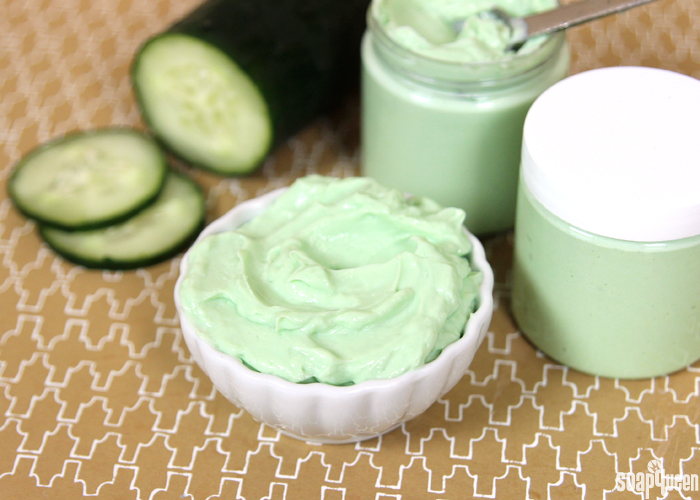 A light green color is perfect for a cucumber themed projects, like the Easy Creamy Cucumber Lotion DIY.
A light green color is perfect for a cucumber themed projects, like the Easy Creamy Cucumber Lotion DIY.
LabColors also work great in salts and scrubs. In the Margarita Epsom Salt Scrub, a combination of Lime LabColor and Emerald LabColor create a perfect margarita color. If you don’t have any LabColors on hand, micas also work well in scrubs. Apple Moss Green Mica and Evergreen Mica are layered in the Apple & Sage Salt Scrub. Don’t forget about La Bomb colorants! They are great for use in bath fizzies because they don’t set off the fizzing reaction. Irish Green La Bomb Colorant creates a calming hue in the Aloe Bubble Bath Bomb Tutorial.
 Top, clockwise: Apple & Sage Salt Scrub, Margarita Epsom Salt Scrub, Aloe Bubble Bath Bombs
Top, clockwise: Apple & Sage Salt Scrub, Margarita Epsom Salt Scrub, Aloe Bubble Bath Bombs
Be on the lookout for new green inspired tutorials this week. I can’t wait to see all your green projects! Don’t forget to use the hashtag #SoaptheRainbow so I don’t miss them.
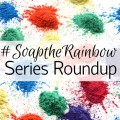
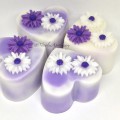
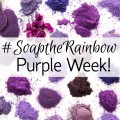
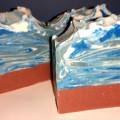
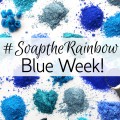
Just made a green soap! My darling daughter helped, we can’t wait to see how it turns out. I just recently started using a local New Zealand grown pomace olive oil, previously having used imported Spanish pomace. The new oil is much greener than the Spanish brand and with the addition of NZ avocado oil and rosemary infused sunflower oil the oils went very very green. However when we added the lye solution to the oils they turned caramel colored almost immediately hrumph! So the bright green that I usually get from the green clay and the chlorophyll colorant were not as intense. Soap is sitting in a nice warm spot near the fire to gell, much to the dogs disgust – it is winter here and the workshop doesn’t hold the heat at night. Hopefully gell phase will brighten things up.
Oh I’m sorry about that Xartep! Sometimes the lye can react with the ingredients in the soap and turn the water brown. It sometimes helps to cool or freeze the water before adding the lye. That keeps the temperatures lower and helps prevent some of the color change. Let us know how the soap looks when it’s cut! It sounds awesome. 🙂
-Kelsey with Bramble Berry
It’s my favorite color! You’ve managed to get some awesome shades of green in those soaps. I am still hunting for a lip safe green for lime lip balms.
I love green as well! It’s beautiful on its own or with other colors. Also, Shamrock Green Mica is lip safe! You can pair it with a bit of Yellow Lip Safe Mica to get a lovely lime green. 🙂
Shamrock Green Mica: https://www.brambleberry.com/Shamrock-Green-Mica-P3071.aspx
Yellow Lip Safe Mica: https://www.brambleberry.com/Yellow-Lip-Safe-Mica-P3074.aspx
-Kelsey with Bramble Berry